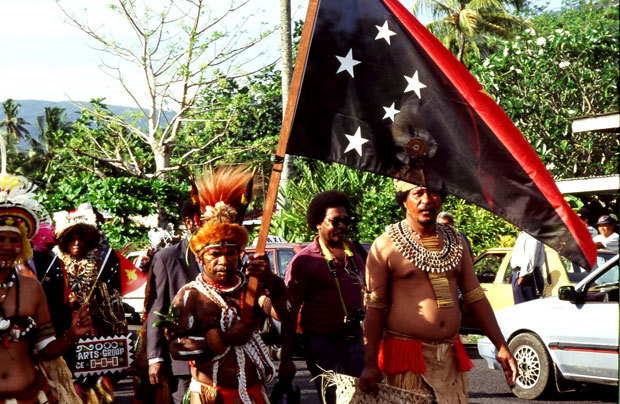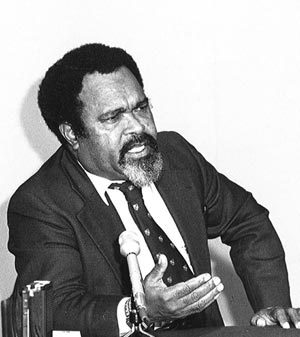Papua New Guinea - a brief history
Sometimes called the 'giant of the Pacific', Papua New Guinea has twice as many people (more than 5 million, mostly Melanesian) and twice as much land (462,000 km²) as all the other Pacific islands added together.
Richer than its neighbours in minerals, agricultural production and diversity of languages, cultures and flora and fauna, it is the only Pacific country to have a land border (with Indonesia's West Papua - Irian Jaya - to its west). Papua and New Guinea used to be separate entities, influenced and colonized over 250 years by the Sultanate of Tidore, Holland, Germany, Britain and Japan. In 1885 Germany annexed the northern coast 'New Guinea' and Britain annexed the southern regions 'Papua'. In 1906 Britain transferred the Territory of Papua to Australia, and in World War I Australia invaded German New Guinea and assumed control under a League of Nations mandate. Under a UN Trusteeship Agreement, Australia took control of both territories in 1945. In 1949 they became one - Papua New Guinea - and achieved independence in 1975.
Early European contact – and colonisation
Four hundred years earlier, these highlands and islands in the western Pacific between the equator and 10 degrees south, reminded Spanish explorer de Doda of Africa's Guinea coast. Setting a pattern for all 'discoverers' of Melanesia he gave the archipelago a foreign, second-hand name, New Guinea.
By the 1800s Dutch skippers were trading round the coast from what is now Indonesia and unscrupulous blackbirders were transporting kanaka slaves to Queensland and Fiji. Some 20,000 were taken until 1884, when the trade was stopped. After a 'divide and swap' deal in 1889, the northern highlands and islands became the German colony of New Guinea while southern, largely coastal, Papua was declared a British Protectorate. To mark the accession, Sir William McGgregor and his bagpiper climbed, claimed and named the 4000 metre Mount Victoria. The skirl of the pipes is still heard today when the PNG Police are on parade. British rule continued in Papua until 1906 when it was passed to recently federated Australia.
'South Seas' – a German commercial syndicate – was responsible for New Guinea but was hampered by malaria and tribal hostility and in 1899 the German Government took over and increased trade and agricultural production until World War One began in 1914.
For the next 30 years the two territories were run by Australian administrations described as "stale, short-sighted and unimaginative".
Papua made some economic progress but New Guinea stood still.
Impact of war
World War Two brought dramatic change. By 1942 Japanese troops were within 50 km of Papua's capital, Port Moresby, and some quarter of a million men were killed or wounded before the invaders were repulsed. PNG soldiers, trackers and bearers made major contributions to the war effort and were so changed in the process that it became inevitable, according to commentators, that they would soon demand political equality and even independence.
Slow political change – but pressure for independence
The first steps in that direction came in 1946, when the UN's Trusteeship Agreement required Australia to give the people of PNG
"a progressively increasing share in the administration and other services of the Territory". But progress was very slow.
By 1961 PNG residents were being elected to the Legislative Council but indigenous people still could not vote. After UN, African, Asian, Commonwealth and even USA pressure, a House of Assembly with more voters and more members was established. By the early 1970s, PANGU (the biggest political party, led by Michael Somare) was calling for early self-government, with strong support from Gough Whitlam's Australian Labour Party which would come into power in 1972.
But 80 years of political stagnation followed by 10 years of haste had not laid a sound base for the move to independence. More than half the population was illiterate and only a few PNG citizens held significant commercial or public positions. Apart from some coffee farmers, PNG citizens generally lived by subsistence farming or low paid work; many had had little contact with government or outsiders and concern for tribe or clan far outweighed any sense of national responsibility or nationhood; inter-racial relationships were often soured by arrogance, envy and resentment.

Independence eventually achieved
In 1971, after copra prices fell and unemployment rose, riots broke out around Rabaul. A District Commissioner was murdered and confidence in the church and the police weakened. There was also widespread apprehension that independence would give powerful tribal groups, and foreigners, more opportunity to take land from its present owners. After agreeing on a fair and effective policy safeguarding land rights and transfers, leaders like Michael Somare, John Guise, John Kaputin, Albert Maori Kiki and Julius Chan were able to persuade their followers to set dissatisfaction aside and work confidently together towards self-government. That was achieved in 1973 under Chief Minister Michael Somare.
On 16 September 1975, Somare's Pangu Party joined Julius Chan's People's Progressive Party to form the first government of independent Papua New Guinea led by Prime Minister Chief (later Sir) Michael Somare. He told interviewer Ian Johnstone he had known for fifteen years that independence was bound to come.
Interview with Dame Carol Kidu
Significant events since independence
1977 Government of Pangu, People's Progressive Party, Mataungan Assn and independent re-elected under PM Michael Somare.
1978 Somare introduces Leadership Code stating MP's responsibilities. PPP quits coalition; Pangu continues to govern backed by United Party.
1980 PPP and 3 coalition partners forms government under PM Julius Chan.
1982 Pangu wins General Election under PM Somare.
1985 After no-confidence vote, 5-party coalition forms government under PM Paias Wingti.
1987 Coalition wins General Election under PM Wingti.
1988 After no-confidence vote, Pangu forms government under PM Rabbie Namaliu.
1989 Bougainville Revolutionary Army close down Panguna copper mine, declare Bougainville independent.
1992 Wingti elected PM.
1994 After no-confidence vote, PM Wingti replaced by Chan.
1997 Bill Skate elected PM.
1998 Tsunami kills 1,500 people on north coast.
Permanent cease fire signed and Autonomous Bougainville Government established under President Joseph Kabui.
1999 After no-confidence vote, PM Skate replaced Mekere Morauta
2001 Law prohibits party loyalty shifts by MPs.
2002 Michael Somare re-elected PM
2003 Limited preferential voting at General Elections introduced
2007 Somare re-elected PM: now Commonwealth’s longest-serving Parliamentarian
2010 John Momis elected President, Autonomous Bougainville Government

Chief Sir Michael Somare